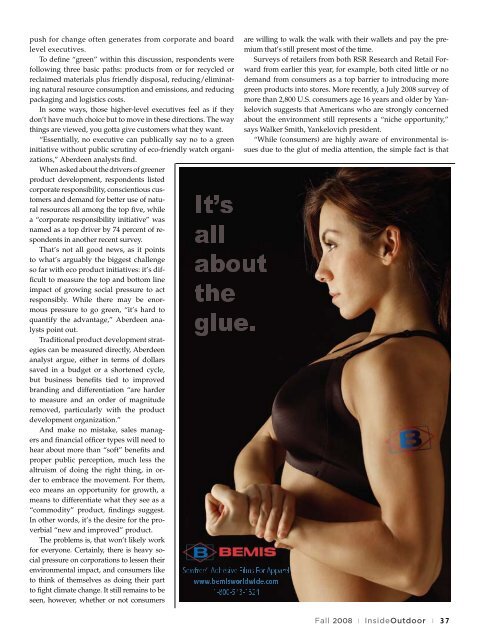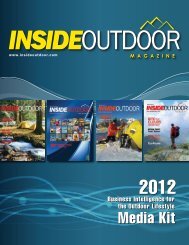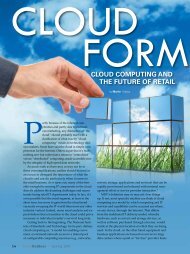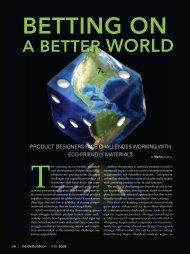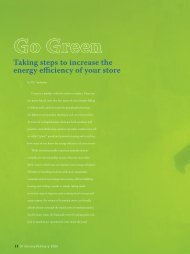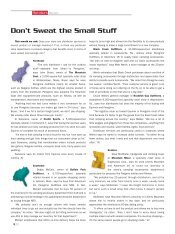Fall - InsideOutdoor Magazine
Fall - InsideOutdoor Magazine
Fall - InsideOutdoor Magazine
Create successful ePaper yourself
Turn your PDF publications into a flip-book with our unique Google optimized e-Paper software.
push for change often generates from corporate and board<br />
level executives.<br />
To define “green” within this discussion, respondents were<br />
following three basic paths: products from or for recycled or<br />
reclaimed materials plus friendly disposal, reducing/eliminating<br />
natural resource consumption and emissions, and reducing<br />
packaging and logistics costs.<br />
In some ways, those higher-level executives feel as if they<br />
don’t have much choice but to move in these directions. The way<br />
things are viewed, you gotta give customers what they want.<br />
“Essentially, no executive can publically say no to a green<br />
initiative without public scrutiny of eco-friendly watch organizations,”<br />
Aberdeen analysts find.<br />
When asked about the drivers of greener<br />
product development, respondents listed<br />
corporate responsibility, conscientious customers<br />
and demand for better use of natural<br />
resources all among the top five, while<br />
a “corporate responsibility initiative” was<br />
named as a top driver by 74 percent of respondents<br />
in another recent survey.<br />
That’s not all good news, as it points<br />
to what’s arguably the biggest challenge<br />
so far with eco product initiatives: it’s difficult<br />
to measure the top and bottom line<br />
impact of growing social pressure to act<br />
responsibly. While there may be enormous<br />
pressure to go green, “it’s hard to<br />
quantify the advantage,” Aberdeen analysts<br />
point out.<br />
Traditional product development strategies<br />
can be measured directly, Aberdeen<br />
analyst argue, either in terms of dollars<br />
saved in a budget or a shortened cycle,<br />
but business benefits tied to improved<br />
branding and differentiation “are harder<br />
to measure and an order of magnitude<br />
removed, particularly with the product<br />
development organization.”<br />
And make no mistake, sales managers<br />
and financial officer types will need to<br />
hear about more than “soft” benefits and<br />
proper public perception, much less the<br />
altruism of doing the right thing, in order<br />
to embrace the movement. For them,<br />
eco means an opportunity for growth, a<br />
means to differentiate what they see as a<br />
“commodity” product, findings suggest.<br />
In other words, it’s the desire for the proverbial<br />
“new and improved” product.<br />
The problems is, that won’t likely work<br />
for everyone. Certainly, there is heavy social<br />
pressure on corporations to lessen their<br />
environmental impact, and consumers like<br />
to think of themselves as doing their part<br />
to fight climate change. It still remains to be<br />
seen, however, whether or not consumers<br />
are willing to walk the walk with their wallets and pay the premium<br />
that’s still present most of the time.<br />
Surveys of retailers from both RSR Research and Retail Forward<br />
from earlier this year, for example, both cited little or no<br />
demand from consumers as a top barrier to introducing more<br />
green products into stores. More recently, a July 2008 survey of<br />
more than 2,800 U.S. consumers age 16 years and older by Yankelovich<br />
suggests that Americans who are strongly concerned<br />
about the environment still represents a “niche opportunity,”<br />
says Walker Smith, Yankelovich president.<br />
“While (consumers) are highly aware of environmental issues<br />
due to the glut of media attention, the simple fact is that<br />
<strong>Fall</strong> 2008 | <strong>InsideOutdoor</strong> | 37


